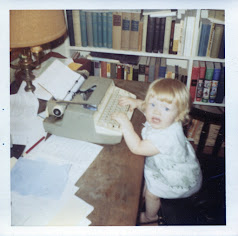A journal of my search for my ancestors and their stories. I started as a name collector and now I am a family historian and preservationist. Join me as I share what I learn.
Friday, November 3, 2017
Gen Doc Study Group - Week 2
I can't recommend DearMYRTLE's Gen Doc Study Group enough. This series is not just for beginners - anyone can learn something from this wonderful panel. The examples of work product that were shared in Week Two were fantastic and so interesting. Want to see an example of Dr. Jones' editing for the NGS Quarterly? Watch.
You can find DearMYRTLE's new blog, Myrt's Musings here - then click on Hangouts near the upper-right of the page. To register for upcoming hangouts, click on the NEXT Hangout tab, which usually has all of the hangouts for the current month. To register for past hangouts click on Archives. This is the best way to view the hangouts because you will be able to see the chat that occurred during the hangout and follow links to the panelists' homework and any other sites they discussed.
Chapter Two of Mastering Genealogical Documentation is "Noncitation Aspects of Genealogical Documentation." Dr. Jones not only brings his considerable experience to this chapter, he also weaves in content from The Chicago Manual of Style and Genealogy Standards.
There was a lot of great material in this chapter but the part that interested me the most was the section on reference note content; maybe because I have no experience with creating reference notes from multiple citations or that include notes about the data or the sources, etc.
Each chapter of Mastering Genealogical Documentation ends with a series of questions. In Chapter One the questions were only about the material in the text but in Chapter Two there were also exercises where Dr. Jones uses his own revised NGSQ (National Genealogical Society Quarterly) article as the reference. So, having read the chapter twice, watched the hangout and read the panelists' homework, I completed the exercises which were helpful but left me wanting to explore a bit more.
Next I turned to the article that the NGSQ study groups will be discussing this month, Sue Hahney Kratch, "James Wesley Mooney of Will County, Illinois: Business Records Reveal His New York Family." from the September 2015 issue. The article and research were interesting, but it was the reference notes that I read with a new appreciation for their content. Previously, I only read the notes to get information about the sources, now I was looking to see how each note was constructed, how many citations were contained in each one and what additional information the author had given us in each note. I know it's mostly my inexperience talking, but wow, it certainly felt as if the research was the easiest part of this article!
As Dr. Jones explains in his Preface, this book is a text, not a reference like Elizabeth Shown Mills' Evidence Explained, and he is giving us the tools to craft citations no matter the source. The elements of Chapter Two are part of the foundation without which our documentation will utterly fail in its goals - communicating the qualities of the source, how to find the source and showing the scope of the genealogist's research.
Subscribe to:
Post Comments (Atom)
Spring Cleaning - Bookmarks
I made it! My desktop PC was getting slower and slower last week, but my new laptop shipped earlier than expected and arrived on Friday and ...

-
I made it! My desktop PC was getting slower and slower last week, but my new laptop shipped earlier than expected and arrived on Friday and ...
-
As part of Heather Wilkinson Rojo 's Honor Roll Project , I have transcribed these Rolls of Honor in Glen Cove, NY to make the names v...
-
Baldwin Veterans Memorial Plaza is part of a beautiful park on a pond in Baldwin, NY that holds many monuments and plaques honoring those wh...




No comments:
Post a Comment
If you don't wish to share your email address, please comment anonymously. Thank you.